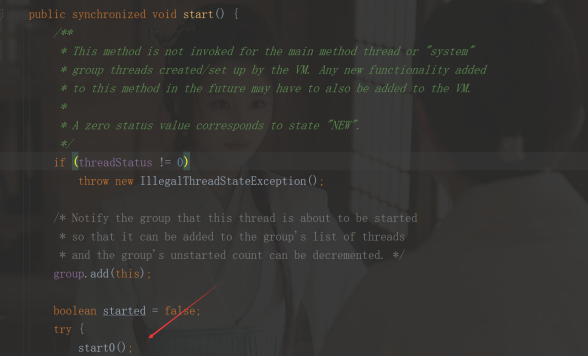Java线程本质
java当中的线程和操作系统的线程是什么关系?
关于操作系统的线程 linux操作系统的线程控制原语
int pthread create(pthread t *thread, const pthread attr t *attr, void *(*start_routine) (void *), void *arg);
可以在linux系统下面通过man手册查看该函数的定义

根据man配置的信息可以得出pthread_create会创建一个线程,这个函数是linux系统的函数,可以用C或者C++直接调用,上面信息也告诉程序员这个函数在pthread.h,这个函数有四个参数
|
参数名字 |
参数定义 |
参数解释 |
|
pthread_t *thread |
传出参数,调用之后会传出被创建 线程的id |
定义 pthread_t pid;继而取地址 &pid |
|
const pthread_attr_t *attr |
线程属性,关于线程属性是linux 的知识 |
一般传NULL,保持默认属性 |
|
void (start_routine) (void *) |
线程的启动后的主体函数 |
需要你定义一个函数,然后传函 数名即可 |
|
void *arg |
主体函数的参数 |
没有可以传nulll |
linux上启动一个线程的代码:
//头文件 #include <pthread.h> #include <stdio.h> //定义一个变量,接受创建线程后的线程id pthread_t pid; //定义线程的主体函数 void* thread entity(void* arg) { printf("i am new Thread! from c"); } //main方法,程序入口,main和java的main一样会产生一个进程,继而产生一个main线程 int main() { //调用操作系统的函数创建线程,注意四个参数 pthread create(&pid,NULL,thread entity,NULL); //usleep是睡眠的意思,那么这里的睡眠是让谁睡眠呢? //为什么需要睡眠?如果不睡眠会出现什么情况 usleep(100); printf("main\n"); }
假设有了上面知识的铺垫,那么可以试想一下java的线程模型到底是什么情况呢?
在java代码里启动一个线程的代码
public class Example4Start { public static void main(String[] args) { Thread thread = new Thread(){ @Override public void run() { System.out.println("i am new Thread! from java "); } }; thread.start(); } }
这里启动的线程和上面我们通过linux的pthread_create函数启动的线程有什么关系呢?只能去可以查看start()的源码了,看看java的start()到底干了什么事才能对比出来。start方法的源码的部分截图

可以看到这个方法最核心的就是调用了一个start0方法,而start0方法又是一个native方法,故而如果要搞明白start0我们需要查看Hotspot的源码,好吧那我们就来看一下Hotspot的源码吧,Hotspot的源码怎么看么?一般直接看openjdk的源码,openjdk的源码如何查看、编译调试?openjdk的编译我们后面会讨论,在没有openjdk的情况下,我们做一个大胆的猜测,java级别的线程其实就是操作系统级别的线程,什么意思呢?说白了我们大胆猜想 star----->start0------------>ptherad_create
我们鉴于这个猜想来模拟实现一下java启动线程
public class EnjoyThread { public static void main(String[] args) { //自己定义的一个类 EnjoyThread enjoythread =new EnjoyThread(); enjoythread.start0(); } //本地方法 private native void start0(); }
这里我们让自己写的start0调用一个本地方法,在本地方法里面去启动一个系统线程,好吧我们写一个c程序来启动本地线程
本地方法的代码编写
#include <pthread.h> #include <stdio.h> //定义变量接受线程id pthread t pid; //线程的主体方法相当于 java当中的run void* thread entity(void* arg) { //子线程死循环 while(1){ //睡眠100毫秒 usleep(100); //打印 printf("I am new Thread\n"); } } //c语言的主方法入口方法,相当于java的main int main() { //调用linux的系统的函数创建一个线程 pthread create(&pid,NULL,thread entity,NULL); //主线程死循环 while(1){ //睡眠100毫秒 usleep(100); //打印 printf("I am main\n"); } }
在linux上编译、运行上述C程序
编译这个程序
gcc thread.c -o thread.out -pthread
运行这个程序
./thread.out
结果如图所示

结果是两个线程一直在交替执行,得到我们预期的结果。现在的问题就是我们如何通过start0调用这个c程序,这里就要用到JNI了
java利用JNI调用本地方法
package com.enjoy.concurrency; public class EnjoyThread { //装载库,保证JVM在启动的时候就会装载,故而一般是也给static static { System.loadLibrary( "EnjoyThreadNative" ); } public static void main(String[] args) { EnjoyThread enjoyThread =new EnjoyThread(); enjoyThread.start0(); } private native void start0(); }
这样完全还原java当中调用JVM源码启动线程的场景,继而可以系统的了解java线程的模型和本质



 浙公网安备 33010602011771号
浙公网安备 33010602011771号